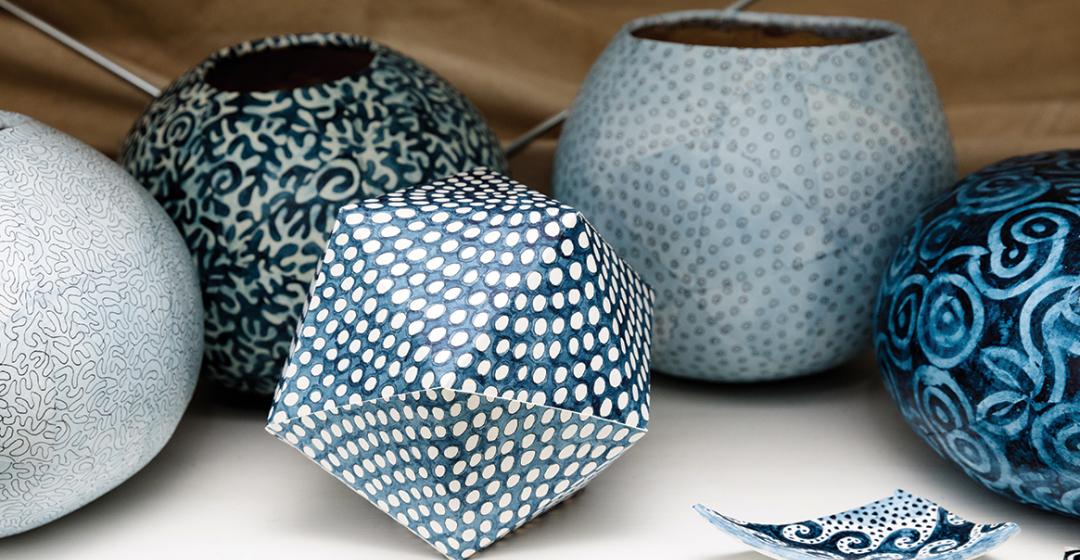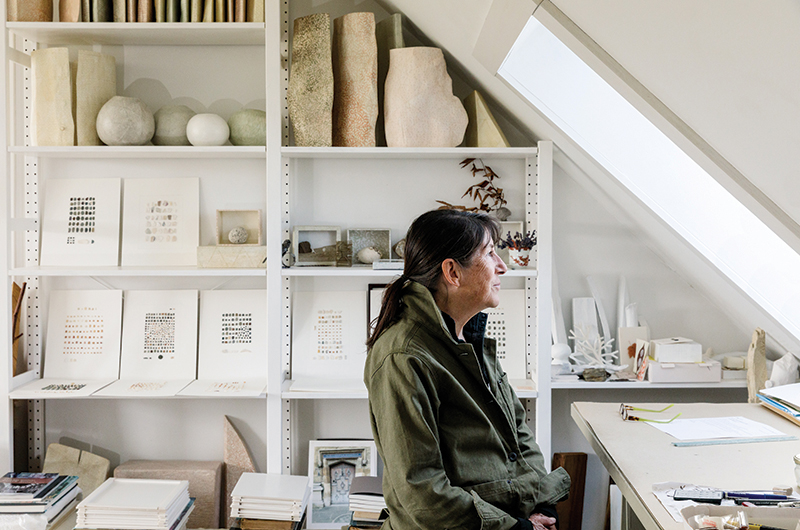The artist Lucy Mitchell has a natural eye for the presence of wonder in the world. She sees it in the celestial sparkle of grains of sand, and in the way that beach stones have stories to tell. Mitchell has been walking Vineyard beaches and woodland trails almost all her life, having moved to the Island with her parents at the age of six, so it is not surprising that she senses the beauty of seaweed, which she presses and frames as an example of design, or of an aged tree stump, which suggests the torso of an ancient Greek hero when covered with gray paper. She sees a tangled clump of twigs as a rare piece of coral when given a wash of bright orange paint. She sees mystery in the perfect shape of eggs, those ancient symbols of birth and rebirth, which she transforms into their own works of art with the delicate patterns of her line drawings.
All these items and many more are among the “found objects” that have inspired Mitchell’s art and animate her various works: drawings, sculptures, collages, and boxes large and small, which she fills with exotica from nature and her own life. Last summer, the Martha’s Vineyard Museum mounted a large and highly praised show of her works, hundreds of objects that she had arranged on the walls of a single room at the museum under the title Recollection: A Personal Museum.
The show was Mitchell’s own version of the collections known as Cabinets of Curiosities, which first appeared in Europe at the beginning of the sixteenth century, assembled by apothecaries, physicians, botanists, scholars, and noblemen who wanted to display items of knowledge that could enlighten the world. Those cabinets, the ancestors of museums, sometimes as grand as a gilded salon or a Renaissance rotunda, sometimes as simple as a cupboard or shelves or a glass-faced case, contained such objects as rare plants and stuffed birds, tortoise shells, precious stones, musical instruments, and antique paintings, as well as skulls and dinosaur bones, a two-headed calf and misshapen fish, a medical invention or an Egyptian mummy. Sometimes, for effect, a large crocodile was hung from the ceiling of an exhibit. It all amounted to a newly discovered world on display.
In tribute to the centuries of collecting and the artists who preceded her, Mitchell sometimes includes in her exhibits a small postcard featuring the self-portrait of the celebrated eighteenth-century painter and collector Charles Willson Peale, which shows him raising a tasseled curtain to reveal his collection in the Long Room at Independence Hall. In the eighteenth century, Peale, a naturalist, scientist, and an inventor (as well as the painter of the famous portrait of President George Washington and other American presidents), founded the first museum of natural history in the United States. Known as Peale’s Museum or the Philadelphia Museum, it opened to the public in 1786 and over the years featured specimens – including a skeleton of a mastodon – and his own paintings. Mitchell also makes frequent references in her own cabinets to favorite items of collection in the long ago past: eggs, already mentioned, which she might arrange in the company of similarly shaped pieces of rock to trick the eye or adorn with tiny patterns of letters or numerals, which suggest messages from another world. One of Mitchell’s prize acquisitions is a goose egg covered with barnacles, found by a friend in the vicinity of James Pond at Lambert’s Cove, which looks like the sort of mysterious sea monster beloved by eighteenth-century collectors of rare oddities. Another item that evokes a sense of the magic recorded in nature is a small black stone that has been inset with a delicate white question mark. Mitchell calls it Enigma. It could be her lodestar.
Mitchell is quiet and gentle by nature, a happy explorer who laughs a lot, sometimes at herself. She is never boastful, but she talks both willingly and enthusiastically about both her work and herself, which seem to be all of a piece. She tells of her teenage desire to be an artist and her lasting interest in all aspects of science, which led her to attend a small progressive art school in Dartington, England, which she loved. It had been named for the Dart River, and the area was all green and rural, like Chilmark, she remembers.
“From my childhood immersion in English novels too, I felt that I already knew the place. Dartington had no didactic like other institutions but was concerned with materials. When I came back to the Island [about forty years ago], I considered myself an artist.
“We had collected plants for artwork at school,” she said, “which led to my early collages, which were flat. I would cut leaves to use like materials, for example, or embellish a find from nature with drawings and frame it.”
Mitchell’s boxes and three-dimensional objects came later. She was wary of more structure and didn’t want to copy the work of Joseph Cornell, she remembers. She had always loved the small-scale objects that her father made for pleasure: tiny furniture, a miniature wheelbarrow and rake that seemed all the more expressive for their size. “He had an influence on me too,” she says with a smile. “I had also begun to think about making boxes into little museums.”
Mitchell has been at work as an artist and the curator of her personal museums for several decades now, with regular gallery shows on the Island, including some with her sister, Julia, who is an eminent designer and weaver of tapestries of nature. There have been two one-of-a-kind exhibitions as well: one set at the Maine College of Art that featured mazes through vast empty spaces marked with beach stones, through which visitors threaded their way. “I learned a lot about using bare space,” she notes. The other, a yearlong installation sponsored by the department of anthropology and archeology at Columbia University in New York City, was accompanied by a series of lectures.
Mitchell loves the idea of museums with the same passion that she loves libraries and books, which appear in various ways in her work; she can be as full of surprises as her repository of found objects. Her standing sculptures, for example, which she might place in an exhibit, like statues or generals, are end cuts of trees from the sawmill that she has covered with paper made to resemble a mottled and mystical sort of bark. They are as beautiful as a wasp’s papery nest or a lineup of tiny stones from the sea, and they also pose questions about the nature of nature. Mitchell is looking for connections, and she is also sharing her memories.






